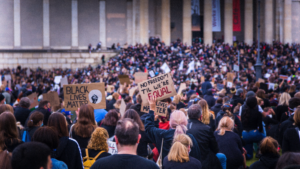🚧 Protest on the Highway: Why Traffic Is the New Front Line of Civil Disobedience
Horns beeping and tires screeching in 2025 aren’t merely traffic noise; they’re the new protest drumbeat. Civil disobedience has turned highways across the US into battlegrounds for climate justice and civil rights. Protesters are taking their tactics to a new level, laying down on highways, attaching themselves to overpasses, and effectively blocking traffic. By doing so, they are sending a strong message: things can’t continue as they are.
⛔ Why the Highway?
The modern United States is circulated by highways. Transporting commodities, employees, and their families, they exemplify the capitalist system’s movement. When demonstrators obstruct them, they cause more than simply trouble; they cause chaos.
The advantages of traffic barriers are:
- Disrupting a major road guarantees widespread news coverage.
- Though divisive, it brings the subject into the open and makes people talk about it every day.
- Roads symbolize advancement and mobility, which gives them symbolic power. Their abolition would threaten the current order.
Protesters see these disturbances as vital forms of peaceful resistance, similar to the sit-ins that occurred during the Civil Rights Movement, except this time they’re taking place on asphalt instead of lunch counters.
🌍 Climate Protests: Just Stop Oil Leads the Way
The environmental organization Just Stop Oil (JSO) is a leading figure in the highway protest campaign. Their recent notoriety has grown as a result of their role in obstructing UK motorways and sparking comparable protests in the US.
Their strategies:
- They encircle important thoroughfares in a chain
- Using road paint or oil substitutes
- Arranging banners by scaling gantries
Despite the backlash, these initiatives have brought climate change into the public eye and into political debate, leading to more than 3,300 arrests. Proponents of JSO and related U.S. groups contend that the continuation of fossil fuel projects necessitates immediate interruption in order to achieve necessary change.
✊ Beyond the Climate: Broader Civil Movements
Environmental issues are just one of many that can spark traffic demonstrations.
- Highways have been blocked by racial justice demonstrators following police brutality.
- In 2024 and 2025, groups of Palestinian solidarity shut down freeways in a coordinated effort to protest U.S. foreign policy.
- In the aftermath of the Roe v. Wade decision, pro-choice advocates utilized highways in crucial swing states.
Protesters are trying to make themselves heard by doing these things. Although traffic jams aren’t usually covered in the evening news, they nonetheless impact everyone—making drivers wonder “What’s going on?” and, at times, “Why are they doing this?”
⚖️ Legal Crackdown and the Debate Over Rights
However, not everyone is in favor of the strategies. The proliferation of highway demonstrations has prompted several states to enact stringent anti-blockade legislation:
- Obstructing highways now carries a threefold fine in Louisiana.
- Sentence lengthening and penalty escalating measures were approved in South Dakota and Tennessee.
- Even more alarmingly, other plans would shield motorists who strike demonstrators on the grounds that they felt endangered.
The conflicting goals of protecting the public and allowing free speech has ignited a heated national discussion about these regulations. Officials from the state maintain that they are safeguarding motorists and emergency services, but civil rights groups contend that the law violates the First Amendment.
Where the right to assemble meets the power of the state, the courtroom is quickly becoming the new battleground.
🧭 What Does This Say About Protest Culture in 2025?
The shift to the roadways is indicative of a more systemic aspect of 2025 protest culture:
- Anxieties is on the rise. Lots of people think that voting, traditional petitions, and marches are too sluggish or useless.
- Being visible is crucial. Pictures of a gridlocked highway are among the most dramatic that may be shared on social media.
- The protest movement is changing. Now, pressure, not permission, is the key. Dictating is not the aim, although disruption is.
The protesters are adjusting to a system that doesn’t appear to care about small changes anymore. Thus, highways are no longer only roadways; they are arenas of paramount importance.
🚦 Final Thoughts: A Nation at a Crossroads
Protests in the United States of 2025 take place all across town, not just in parks and plazas. During rush hour, it can be seen over the bridge or on the freeway during the morning commute. As a symbol of a society on the brink, highway blockades demonstrate that activists are prepared to risk physical harm in order to draw attention to the problems they refuse to let go of.
It has yet to be determined if these strategies result in genuine change or opposition. One thing is certain, though: the path to justice now cuts through the very fabric of the United States of America—and it may be barred just ahead.








